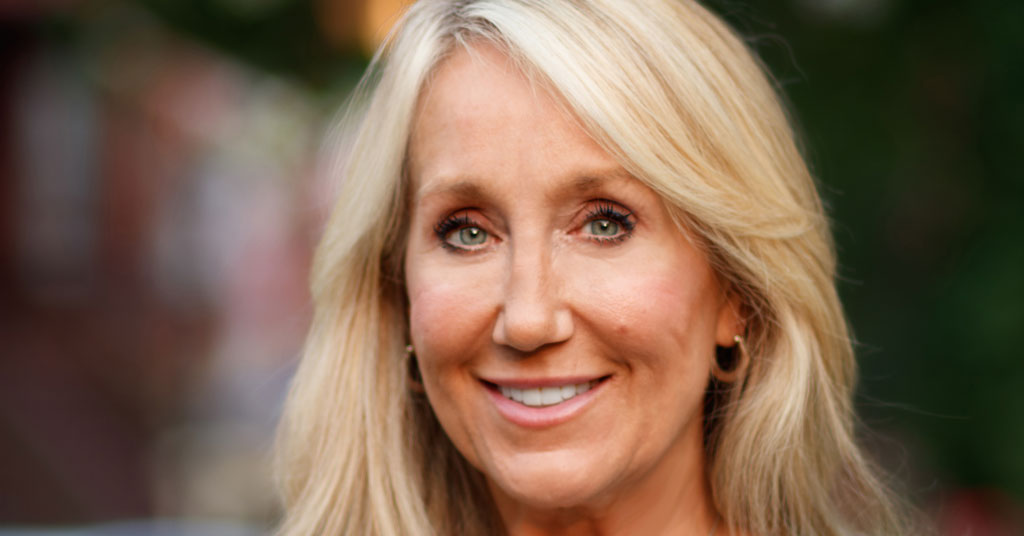A Clean Transition: Zips Cleaners' Mary Ann Donaghy dives into data

Mary Ann Donaghy has been the chief marketing and customer experience officer at Zips Cleaners for a year and a half, but her impact is already being felt. When she signed on, she brought more than three decades of marketing experience to the top marketing office at the Maryland-based garment care brand. She’s focused on driving revenue, profitability, and brand metrics.
As a data-driven marketing leader, Donaghy’s expertise in consumer insights and business analytics has already become influential in guiding Zips’ continued growth. Her focus on creating an exceptional customer experience has come in handy as the brand continues to adapt to the changing work habits and apparel choices of an evolving population.
Franchise success is a group effort, according to Donaghy. She believes in the importance of synergy between the marketing team and the brand’s other departments. “I want and need to be completely aligned with our board, operations team, and technology team in order to ensure that we are all working toward the same goals,” she says.
She boils down the three critical keys to being a successful CMO: listening, making data-backed decisions, and being surrounded by a great team. “Getting the right people in the right roles is at least half the battle. We are very fortunate to have a terrific team of marketers at Zips who work collaboratively to get the job done and done well.”
Donaghy says that today’s franchise prospects and franchisees expect more from brands than in the past, but it works both ways. “A franchise is a partnership in which the franchisor and franchisee must work hand in hand,” she says.
Describe your role as CMO.
I think the role of CMO in any organization is to focus on growing revenues and optimizing business results by building a strong, compelling, and differentiated brand that is of value to consumers. This requires us to deeply understand consumer needs, trends, attitudes, lifestyles, and behaviors. We need to translate that knowledge into creative messaging that is reflective of these dynamics. Curiosity about consumers is critical as it is foundational to understanding decision drivers. Being data focused ensures a focus on the initiatives that matter the most.
What’s the most challenging part of being a CMO today?
Keeping up with the constantly changing landscape of platforms and resources of marketing services and solutions, all of which promise to be the magic bullet, has been the most challenging part for me. But it’s exciting at the same time. There are so many options and opportunities to invest in, and weeding through them is time-consuming and challenging. Some are more proven than others.
How has Covid impacted the way you have led your brand’s marketing efforts?
Covid-19 obviously really hurt the dry-cleaning category because people weren’t going out like they used to, and so many were working from home. Post-Covid, more people are still working from home than pre-Covid. As a result, we have to work harder to make our brand and category relevant and meaningful to consumers of all ages, lifestyles, and routines. We increased our Wash ‘n Fold laundry service marketing and offerings, putting more emphasis on our EZ Drop service that allows you to save time and skip the line, and built a program with DoorDash to allow customers to request pickup and drop-off of their clothes through our app. Focusing on customer conveniences like these empowered us to maintain and eventually gain momentum emerging from the pandemic by broadening our appeal to customers of all ages.
What are the three most important keys to being an effective CMO leader today?
- I think listening is really critical. Marketing is a combination of art and science, and it’s not black and white. We must listen, learn, think, and connect the dots to come up with recommendations that make sense for the business and for customers. We have a great group of leaders at Zips who trust each other, work collaboratively, and are deeply committed to excellence. Many have backgrounds owning and operating their own garment care businesses, so they have great insights and empathy about both our customers and our franchise operators. We listen to each other and consider all factors as we make decisions.
- You have to make decisions based on data combined with a little bit of common sense and gut feeling. The data must come from numerous sources to tell the story that drives the decision. It’s a combination of business analytics, quantitative consumer insights, and third-party data that allows a CMO to understand the opportunities that marketing can capitalize on.
- It’s key to hire great people who are focused on solutions and results and empower them to do their jobs.
How do you prepare a marketing plan and execute the strategies?
We start with data and insights. What do we know about our business, our marketing investments, and our consumers? We look at trends, gaps, and opportunities. There is no shortage of opportunities, but we must be realistic about what we can operationalize. Then we look at available resources and constraints, which includes budget. In our business, we also have seasonality, so that comes into play as we plan. I’m a big believer in “plan the work, work the plan.” Objectives and strategies must be clear up-front so that decisions on tactics are easy to make. If the tactics don’t deliver on the strategies, they don’t make the cut.
How do you measure marketing results and effectiveness?
We are always looking at the cost per impression and conversion from a marketing analytics perspective, but we also look at new customer trends and spend per customer. For customer spending trends, we’re looking at the frequency of visits, number of items per visit, and breadth of services used. As we start to test targeting younger consumers with more relevant messaging and services, we are also looking at the average age of our customers, which is gradually decreasing. I’d like to start measuring brand awareness and consideration in the future, which has been very helpful in previous organizations where I’ve worked.
Discuss your core consumer marketing strategies and objectives.
Our primary research and third-party research that we’ve accessed tell us that our customers are image-conscious and want to look their best every day without breaking the bank. Our creative reinforces our value proposition. We make it easy to look your best for less. We rotate messaging that reinforces how we’re easy and convenient with our EZ Drop service, DoorDash delivery, and “In by 9, out by 5” same-day service at an everyday low price for any garment. We target customers who are lookalikes of our high-value customers based on their demographic and psychographic profiles, including their geography. We know from research that sports are an important part of the lifestyle of our customers, so we invest in sponsoring and doing advertising with a number of local sports teams that have very passionate fan bases. Additionally, we use CRM marketing to remind customers of the benefits of dry cleaning during key periods and provide special discounts periodically. But our main goal is to reinforce our value and differentiation and ultimately achieve a combination of these goals:
- New customers,
- More visits per customer,
- More items per visit,
- Broader services used, and
- Minimized churn.
How do you go about creating a customer-centric marketing and brand philosophy?
By taking the time to conduct primary consumer research among our customers as well as among consumers in our category who go elsewhere. We look at overall consumer trends and gain a deep understanding of what the customer wants and needs from us. We ultimately have to deliver that back to them with our brand messaging and service levels.
Describe your marketing team and the role each of them plays.
We have a marketing manager who focuses on national and regional initiatives, including all paid digital marketing, social media, brand development, and regional sports sponsorships. Our franchise marketing manager works closely with franchisees to develop and implement local store marketing and new store openings. We have a graphic designer, content developer, marketing technologist, and CRM marketing specialist. We all work hand in hand to plan, implement, and analyze all our marketing efforts nationally, regionally, and locally to ensure that all of our 70+ locations get the marketing support they need.
Why is it so important for the marketing department to have a personal touch when it comes to helping the brand connect with franchise prospects?
A good franchisee is the perfect combination of entrepreneur and team player. They have the drive to own, operate, and grow their business but recognize that the franchisor and franchise system can provide support, guidance, insights, and buying power. Each franchisee has a different set of skills and assets that they bring to the table, and all have the desire to succeed. To help them get the most out of being part of our franchise system, we have to recognize each franchisee as an individual and combine templated, system-wide tools with direct interaction at the local level via our franchise marketing manager to help them leverage our brand name optimally within their market.
How does this help your franchise sales and development effort?
With each department in our corporate office, we can demonstrate to prospective franchisees how they will benefit by being part of our franchise: gaining access to a team, institutional and industry knowledge, pricing structures, proven tools and methods, and a passionately protected and promoted brand. We will boost our appeal to new prospects while also giving existing franchisees greater confidence and capability with which to add more units.
What ways/tools do you rely on to do this?
We use SiteZeus and a custom Tableau database. Each provides valuable insights into high-opportunity locations.
Do today’s prospects expect more from the franchise marketing department? What, and how do you provide it?
I think they should expect a lot from marketing. They should expect their marketing department to be data focused, strategic, collaborative, and forthright. But they should also plan to be committed partners in the marketing of their locations.
How is today’s consumer and marketing data helping you fine-tune your marketing initiatives?
There’s great data out there about consumers of our category, and we have our own research and data analytics that we can layer onto that. These data sources are foundational to every decision we make. They help us to understand the demographic and psychographic profiles of our high-value customers, identify growth opportunities, and tap into the emotional and rational decision drivers of category consumption.
Describe the evolving role of social media in your brand’s marketing efforts.
Our core demographic is a bit older, 45 to 65. The category over indexes professionals, so much of our effort in social is on Facebook and LinkedIn. Instagram draws a younger demographic that we’re trying to attract into the category and our brand by promoting some of the services we think reflect the conveniences younger consumers gravitate toward. We have put a lot of emphasis on creating great content on our social channels, and we’ve grown engagement as a result. One area that we really want to tap into is the power of influencers, but we haven’t quite hit the mark in that area yet. It also allows us to promote hyperlocal or location-specific events and promotions. Our brand and value proposition has the potential to gain more relevance through social media. Paid social media has performed better for us than programmatic in terms of driving awareness and impressions, so it’s a foundational part of our marketing mix. We’d like to continue to improve our targeting and content to increase our marketing ROI using social media.
How do you work with other internal departments and does technology help?
Absolutely. It’s imperative that marketing works hand in hand with other departments: operations and technology in particular. Without operations alignment, it’s very hard to build a brand or a consistent customer experience. I’m very focused on creating the alignment and ensuring we are developing and implementing a consistent brand experience across all locations. We have work to do there, but it’s a big priority, and we are committed to achieving it. As for technology, it goes without saying that marketing and technology are completely intertwined. I’ve been working on driving improvements in marketing technology for more than 20 years, and it’s exciting to bring ideas to life by partnering with internal technology partners and external suppliers.
Which technology tools are most valuable to you and why?
Our website, app, and CRM tools (HubSpot) help us bring our value proposition to life, promote our brand, and help our customers do business with us the way they want to. Whether it’s connecting our POS data to Power BI or using HubSpot to get the right messages to the right customers, we are focused on leveraging all available technologies to help us provide more value to customers, create efficiencies, and make better business decisions.
How do you stay on top of changing technology?
We start by working with smart people who stay on top of technology, and then we mine their knowledge to identify application opportunities. I also regularly do demos with new marketing technology companies to keep my finger on the pulse of new resources so that when the need arises, we know who can help us.
How do you manage costs and budgets for the marketing department?
As a franchise business with marketing budget that increases and decreases based on revenues, it can certainly get tricky to ensure we spend within projected revenue levels. We look at historical seasonality, revenue trends, and the media strategy that aligns with the timing of consumer demand levels to allocate and manage costs every month.
Do you see vendors as business partners? Why/why not?
Absolutely. We use them as a resource for expertise and cost efficiencies. They can make a big difference in both revenue and profitability.
How have marketing strategies/tools changed over the past decade? How have you adapted?
The amount of data and ways to analyze and use it have increased significantly. I’ve always been very data and consumer driven, so it’s in my DNA to conduct market research and tap into third-party data. The access to relevant and helpful data has been a continuously positive change in the past 10 years.
How is your marketing/branding strategy developed, and how does it flow through the system?
After doing an analysis of our customers and their buying behaviors combined with primary market research, we learned a lot about our customers and what they want and need from us. This impacted our strategy starting about a year ago. We know the profile of our high-value customers, so we start with targeting lookalikes and “actalikes” of these customers to get the highest lifetime value of newly acquired customers. We also need to bring new consumers into our category and brand. Many of them are much younger than our present high-value customers. From a brand standpoint, there is one common thread between these different consumer groups: They are image-conscious. It may be for different reasons, some for work, some for social, and some for special events, but our customers in particular want to look great every day without spending a lot of money. Zips’ unique value proposition is that we offer the same price every day for every garment. That’s the rational benefit. But the emotional benefit is that you can walk out of your house every day looking, feeling, and smelling fresh without breaking the bank. This insight was derived through quantitative consumer research and has guided us as we improve merchandising, shift messaging, and ultimately train staff to understand.
What advice would you offer to aspiring CMO executives?
Be curious, listen, and understand your customers. Use data to help your decision-making, and collaborate with all stakeholders to bring your opportunities to life.
Share this Feature
Recommended Reading:
| ADVERTISE | SPONSORED CONTENT |
FRANCHISE TOPICS
- Multi-Unit Franchising
- Get Started in Franchising
- Franchise Growth
- Franchise Operations
- Open New Units
- Franchise Leadership
- Franchise Marketing
- Technology
- Franchise Law
- Franchise Awards
- Franchise Rankings
- Franchise Trends
- Franchise Development
- Featured Franchise Stories
FEATURED IN

Franchise Update Magazine: Issue 4, 2024
| ADVERTISE | SPONSORED CONTENT |








 The franchise listed above are not related to or endorsed by Franchise Update or Franchise Update Media Group. We are not engaged in, supporting, or endorsing any specific franchise, business opportunity, company or individual. No statement in this site is to be construed as a recommendation. We encourage prospective franchise buyers to perform extensive due diligence when considering a franchise opportunity.
The franchise listed above are not related to or endorsed by Franchise Update or Franchise Update Media Group. We are not engaged in, supporting, or endorsing any specific franchise, business opportunity, company or individual. No statement in this site is to be construed as a recommendation. We encourage prospective franchise buyers to perform extensive due diligence when considering a franchise opportunity.